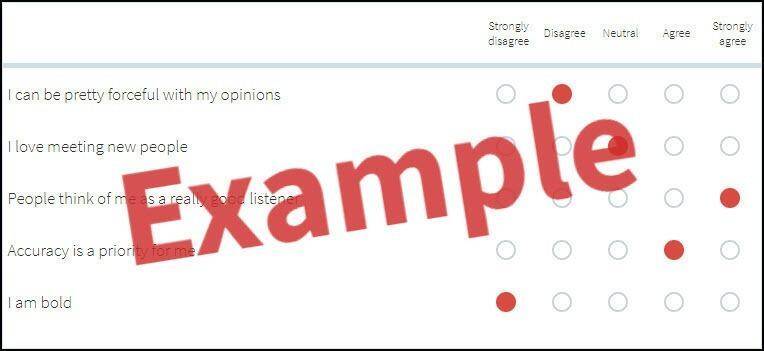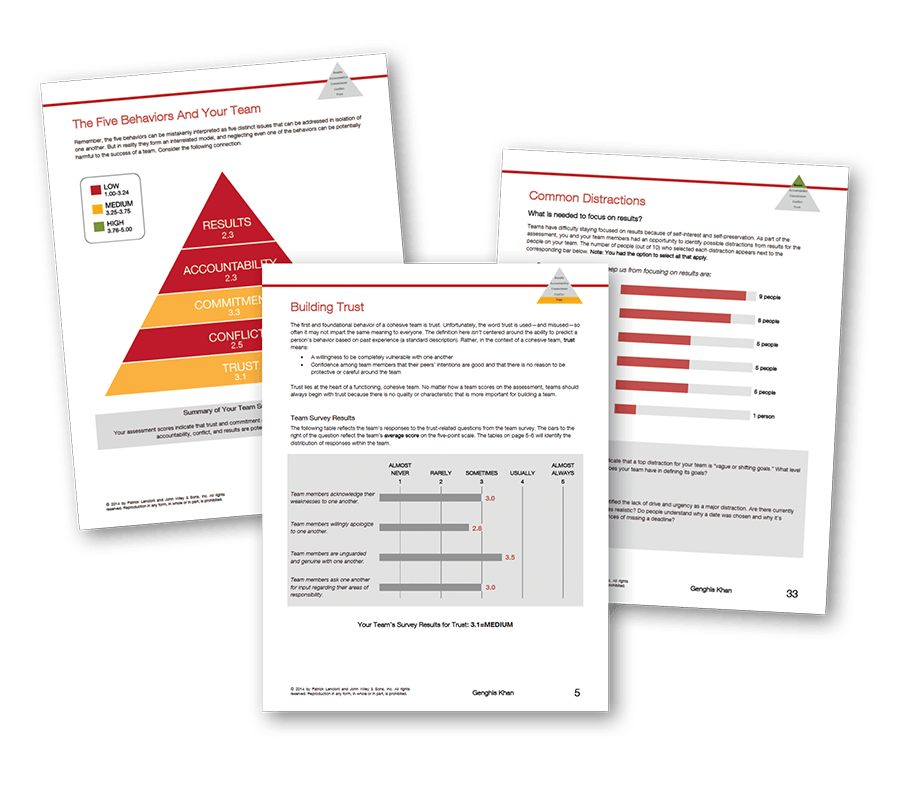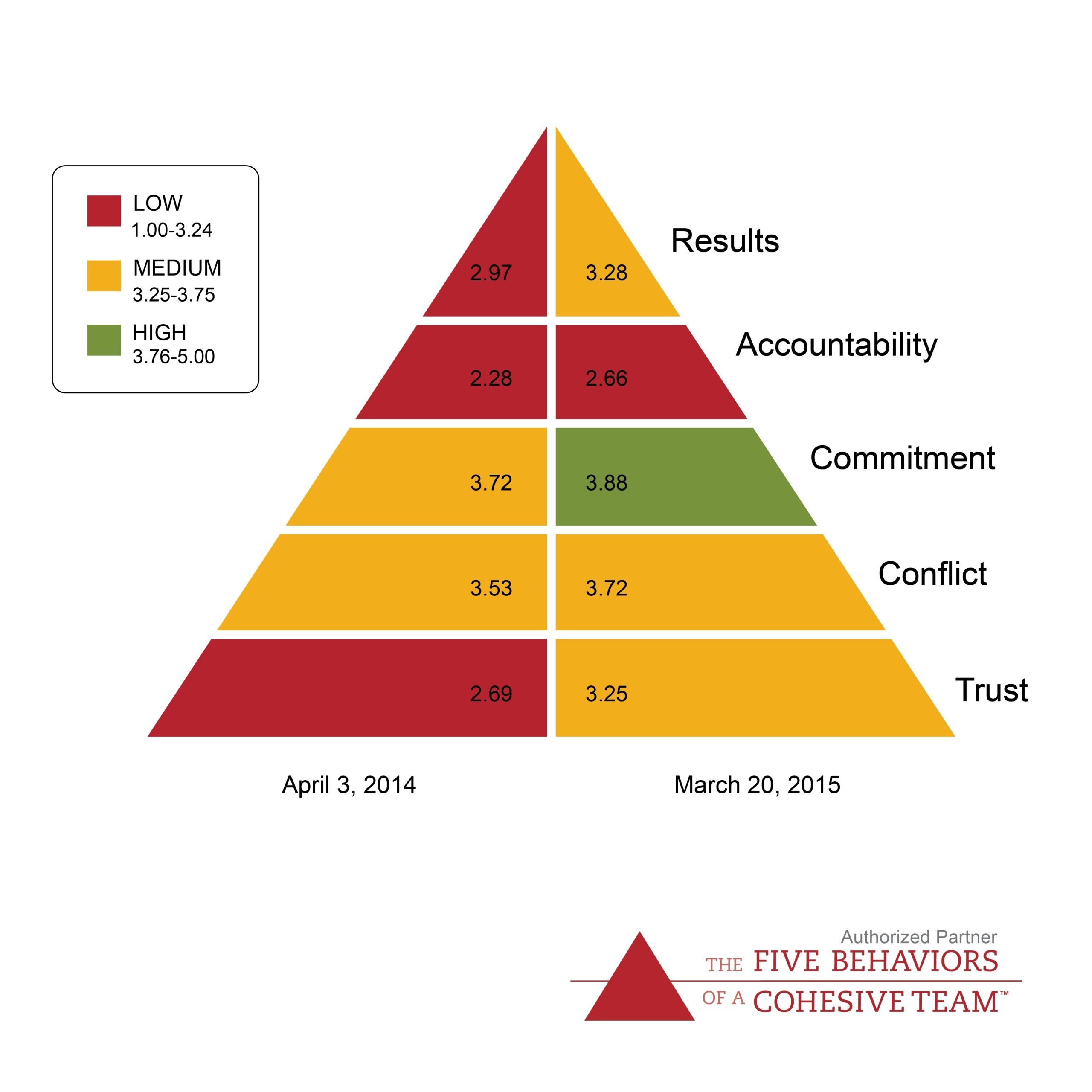Cinq étapes pour améliorer la cohésion d’équipe
Étape 1: Quel test de performance Five Behaviors ?
Formation d’équipe cohérente – Toute étape au-delà de l’étape 1 suppose que:
- Vous avez déjà choisi de travailler avec des partenaires de disque,
- Vous avez suivi le processus de sélection de produit et avez choisi entre Five Behaviors powered by DiSC ou powered by All Types (basé sur les types Jungian, tout comme mbti).
- Vous avez acheté votre code d’accès. Entrez dans le monde des cinq comportements d’une équipe cohésive.
Chez les partenaires de disque, nous sommes un partenaire Wiley autorisé. Nous vous aidons à acheter les cinq comportements d’une équipe cohésive et vous accompagnons dans la mise en œuvre de la formation d’équipe cohérente avec vos équipes, pour améliorer la dynamique d’équipe et la performance d’équipe.
Vous n'avez pas encore votre (vos) code (s) d'accès? Cela signifie probablement que vous n'êtes pas tout à fait prêt ... Voici ce que vous pouvez faire
Chez Disc Partners, nous sommes des formateurs Wiley Authorized Partner et Master Certified Everything DiSC. Nous proposons la gamme complète de produits Wiley DiSC et Five Behaviors disponibles, utilisés dans des sessions d’apprentissage ou de formation facilitées.
Ici vous trouvez les options qui s’offrent à vous
Option 1: Vous avez besoin à la fois de l’évaluation (profils) et des ressources de formation (un animateur) pour animer l’atelier Five Behaviors. Si vous avez besoin d’aide pour prendre les bonnes décisions liées à la formation et au coaching, envisagez de nous contacter directement.
Vous devrez acheter 2 éléments:
- Un rapport d’évaluation et de profil des cinq comportements (pour chaque répondant / apprenant). Chaque participant doit recevoir 1 code d’accès au test de performance de l’équipe Five Behaviors (un questionnaire en ligne) + 1 rapport de profil de test Five Behaviors. Achetez un test de performance d’équipe Five Behaviors + un rapport Five Behaviors pour vos participants / apprenants
- Un atelier d’équipe animé. Faites votre choix parmi: une journée de formation d’équipe Five Behaviors, une formation d’équipe Bespoke Five Behaviors (+) coaching. Acheter un test de performance d’équipe Five Behaviors + rapport + formation ou coaching
Option 2: Vous n’avez besoin que des rapports d’évaluation et de profil et dirigerez votre atelier DiSC avec des ressources internes ou d’autres ressources
Vous pouvez acheter:
- Un rapport d’évaluation et de profil des cinq comportements (pour chaque répondant / apprenant). Chaque participant doit recevoir 1 code d’accès au test de performance de l’équipe Five Behaviors (un questionnaire en ligne) + 1 rapport de profil de test Five Behaviors. Achetez un test de performance d’équipe Five Behaviors + un rapport Five Behaviors pour vos participants / apprenants
Achetez Five Behaviors et son rapport de profil et dirigez votre atelier DiSC de manière autonome.
Visiter le MAGASINou Appelez-nous si vous avez besoin de soutien.
Étape 2: Faire le test Five Behaviors

Formation d’équipe cohésive -Répondre au questionnaire en ligne sur la performance de l’équipe
- Vous avez reçu un code d’accès à l’évaluation Five Behaviors dans votre boîte de réception. Cliquez sur le lien fourni dans cet e-mail et passez à l’étape suivante (ne supprimez pas l’e-mail, vous pourriez en avoir besoin plus tard).
- Vous répondez à un simple questionnaire sur le « comportement de votre équipe ».
Obtenez une meilleure compréhension de la différence entre un test et une évaluation, dans la section FAQ (menu supérieur) consultez: test et évaluation, quelle est la différence? Indice: il n’y a pas de bonnes ou de mauvaises réponses.
Étape 3 : Recevez votre profil d’équipe Five Behaviors
Formation d’équipe cohésive – La plateforme d’évaluation en ligne produit un rapport de profil d’équipe Five Behaviors. Il décrit les forces de votre équipe et les angles morts possibles ainsi que votre style de comportement unique, vos tendances, vos besoins, votre environnement préféré et vos stratégies pour un comportement efficace. Ils vous aident à en savoir plus sur les vôtres et les forces et défis de l’équipe, qui restent simples à comprendre.
Chaque rapport de profil comprend également des informations sur tous les autres styles DiSC ou Tous les types de l’équipe, afin que vous puissiez observer les gens autour de vous et comparer. N’oubliez pas qu’il n’y a pas de bon ou de mauvais dans DiSC ou tous les types.
Les animateurs utilisent souvent des rapports de groupe ou d’autres rapports disponibles pour fournir plus d’informations et une meilleure compréhension de votre équipe et de vos collègues.

Étape 4: Appliquer les recommandations Five Behaviors
Si vous vous arrêtez à ce stade, vous risquez de manquer 90% de la valeur que le rapport de profil DiSC ajouterait à vos connaissances et compétences. La partie impactante de votre expérience DiSC commence à l’étape 3 et les activités de mise en œuvre que vous associez aux recommandations du rapport à l’étape 4. Pour découvrir ce qui rend une équipe efficace, envisagez une mise en œuvre approfondie:

Interprétation des rapports de l’équipe Five Behaviors pour les individus: un à un
développement personnel et le coaching ont du sens, mais le but est de découvrir ce qui rend une équipe efficace. Il s’agit donc d’un programme d’équipe. Considérez un ou plusieurs ateliers d’équipe comme un choix logique pour développer et aligner davantage l’équipe. L’interprétation individuelle est souvent effectuée avec la haute direction pour assurer l’alignement avant de lancer la formation d’équipe cohésive.
Interprétation du profil de l’équipe Five Behaviors lors d’un atelier d’équipe.
Améliorez encore les interactions, la cohésion et l’efficacité de l’équipe. Découvrez des résultats immédiats et visibles à la suite de votre formation d’équipe cohésive sur mesure Five Behaviors.
Étape 5: Continuer avec le rapport de progression gratuit
Formation d’équipe cohésive – Un rapport d’étape de suivi gratuit
Le rapport d’étape met en évidence les domaines de plus grande amélioration et de déclin possible. il offre des points de discussion productifs et suggère un plan d’action pour aider les équipes à établir des priorités et à fixer des objectifs précis. Vous pouvez exécuter plus d’un rapport gratuitement.
Vous serez en mesure de comparer l’évolution des « performances d’une équipe au fil du temps et de mettre en évidence les domaines de plus grande amélioration et de plus grand déclin.
Composants du rapport:
- Le Résultats de l’enquête de l’équipe
- Points de discussion
- Plan d’action: identifier les priorités de l’équipe en matière d’améliorations et définir des objectifs spécifiques
- Annexe: L’impact de votre style DiSC®, la carte Everything DiSC Team Map et la carte Conflict Team

COMMENT POUVONS-NOUS VOUS AIDER ?
COMMENT POUVONS-NOUS VOUS AIDER ?
FOIRE AUX QUESTIONS
Outils DiSC : pour un meilleur management
Souhaitez-vous instaurer de bonnes relations professionnelles ? Mieux communiquer et mieux comprendre le comportement de vos prospects pour mieux vendre ? La méthode DISC constitue la solution à toutes ces problématiques. Cet outil de communication plus efficace apporte de la fluidité à la communication et aux relations interpersonnelles. Découvrez dans le présent article ce qu’est le modèle DISC ? Quelles sont les typologies de profil DISC ? Et pourquoi utiliser l’outil DISC dans le management ?
Qu'est-ce que le modèle DiSC ?
- Dominance (rouge) ;
- Influence (jaune) ;
- Stabilité (vert) ;
- Conformité (bleu).
Pour déterminer le comportement principal d’un individu, Marston a utilisé deux axes. Le premier exprime sa vision de la situation dans un environnement (favorable ou hostile), tandis que le deuxième sur sa propension à agir dans cet environnement (acceptant ou agissant). Cette connaissance de soi vous aide à bien communiquer et à comprendre vos faiblesses.
Sachez que le modèle DISC facilite aussi l’identification des dominantes psychologiques des individus dans un environnement de travail. En tant que manager grâce à l’outil DISC, vous serez en mesure d’adopter un management adéquat si vous parvenez à percevoir le trait dominant de chacun de vos collaborateurs.
Quelles sont les typologies de profils DiSC ?
Issu de l’axe vertical et horizontal, William Marston a déterminé quatre catégories de réactions comportementales avec l’outil DISC. Il a attribué quatre couleurs aux quatre typologies afin de faciliter l’utilisation et la compréhension.
Le profil Disc dominant
Fonceur, puissant, déterminé, tenace, affirmé et souvent visionnaire, le profil dominant recèle d’un potentiel extraordinaire. Ce profil à tendance extravertie ne cherche pas à tourner autour du pot. Il est direct dans son mode de communication (verbale, gestuelle ou non verbale) et n’hésite pas à prendre la parole.
Elle peut paraître autoritaire et agressive avec son entourage, un potentiel danger pour la cohésion d’équipe. Par contre, cette personne a un esprit de compétition, ce qui lui permet de se concentrer sur ses objectifs. Elle s’appuie sur les faits pour agir et avancer. Les chefs d’entreprise et les grands intellectuels partagent ce type de personnalité.
Le profil Disc Influent
La personne ayant le profil Disc influent est de nature sociale, amicale, optimiste, très démonstrative et enthousiaste. Celle-ci entretient un très bon relationnel, ce qui lui permet d’être une personnalité appréciée au sein de l’équipe. Grâce à sa personnalité, elle aime les collaborations et fonctionne selon un mode démocratique.
Néanmoins, cette personne est parfois superficielle dans sa façon de trouver des problématiques et de gérer les dossiers. Son objectif est de susciter l’enthousiasme, de chercher à convaincre, de rechercher la reconnaissance et la collaboration.
Le profil Disc Stable
La personne ayant le profil Disc Stable est de nature calme, patiente, méthodique, loyale, sérieuse, fiable et humble. Ce profil de personnalité, à tendance introvertie et souple, est plutôt résistant au changement. Il est capable d’écouter son interlocuteur et ne s’impose jamais. Il sollicite le travail d’équipe. Son objectif est ainsi de prioriser le soutien et la collaboratio et de rechercher l’équilibre.
Le profil Disc Consciencieux
La personne ayant le profil Disc Consciencieux est de nature discrète, précise, factuelle, autonome, méthodique, organisée, structurée et analytique.
Souvent perçu comme froid et autoritaire, ce genre de profil est à l’aise dans les métiers comptables ou administratifs. Sachez que la personne à tendance introvertie, rigide, et centrée sur les tâches aime l’ordre et suivre les règles. Son objectif est de prioriser la précision, l’équilibre (suivi et modération) et les défis.
Pourquoi utiliser le modèle DISC dans le management ?
- Mieux connaître les autres pour communiquer efficacement ;
- Comprendre les autres et d’adapter à la personnalité ;
- Adopter une écoute empathique et de gérer les situations difficiles ;
- Encourager la communication ;
- Vendre et manager en couleur ;
- Améliorer le savoir-être pour établir des relations positives ;
- Établir un esprit d’équipe
Dans le processus de recrutement, le DISC permet au recruteur de mieux se connaître et comprendre le propre comportement du candidat en cas de stress par exemple. Ainsi, cette clé de communication vous aide aussi à identifier ses motivations, ses faiblesses, ses points forts, ses capacités relationnelles et ses aptitudes.
Dans le process communication management, il permet d’adapter la communication pour mieux se comprendre et mieux coopérer grâce à l’empathie suscitée. Enfin, l’outil DISC vous permet d’adapter à des interlocuteurs et d’anticiper son processus de décision, dans l’approche commerciale.
